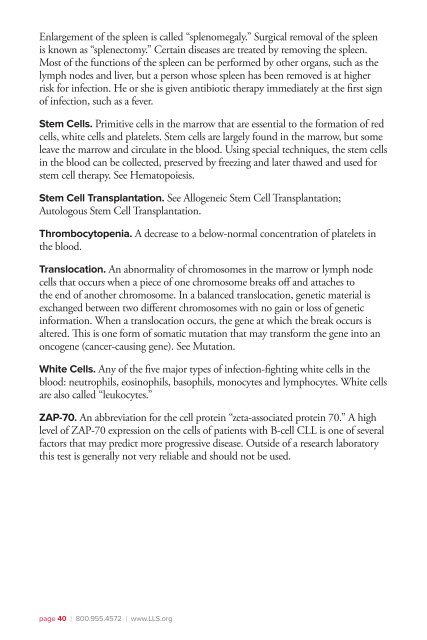Chronic Lymphocytic Leukemia - The Leukemia & Lymphoma Society
Chronic Lymphocytic Leukemia - The Leukemia & Lymphoma Society
Chronic Lymphocytic Leukemia - The Leukemia & Lymphoma Society
You also want an ePaper? Increase the reach of your titles
YUMPU automatically turns print PDFs into web optimized ePapers that Google loves.
Enlargement of the spleen is called “splenomegaly.” Surgical removal of the spleen<br />
is known as “splenectomy.” Certain diseases are treated by removing the spleen.<br />
Most of the functions of the spleen can be performed by other organs, such as the<br />
lymph nodes and liver, but a person whose spleen has been removed is at higher<br />
risk for infection. He or she is given antibiotic therapy immediately at the first sign<br />
of infection, such as a fever.<br />
Stem Cells. Primitive cells in the marrow that are essential to the formation of red<br />
cells, white cells and platelets. Stem cells are largely found in the marrow, but some<br />
leave the marrow and circulate in the blood. Using special techniques, the stem cells<br />
in the blood can be collected, preserved by freezing and later thawed and used for<br />
stem cell therapy. See Hematopoiesis.<br />
Stem Cell Transplantation. See Allogeneic Stem Cell Transplantation;<br />
Autologous Stem Cell Transplantation.<br />
Thrombocytopenia. A decrease to a below-normal concentration of platelets in<br />
the blood.<br />
Translocation. An abnormality of chromosomes in the marrow or lymph node<br />
cells that occurs when a piece of one chromosome breaks off and attaches to<br />
the end of another chromosome. In a balanced translocation, genetic material is<br />
exchanged between two different chromosomes with no gain or loss of genetic<br />
information. When a translocation occurs, the gene at which the break occurs is<br />
altered. This is one form of somatic mutation that may transform the gene into an<br />
oncogene (cancer-causing gene). See Mutation.<br />
White Cells. Any of the five major types of infection-fighting white cells in the<br />
blood: neutrophils, eosinophils, basophils, monocytes and lymphocytes. White cells<br />
are also called “leukocytes.”<br />
ZAP-70. An abbreviation for the cell protein “zeta-associated protein 70.” A high<br />
level of ZAP-70 expression on the cells of patients with B-cell CLL is one of several<br />
factors that may predict more progressive disease. Outside of a research laboratory<br />
this test is generally not very reliable and should not be used.<br />
page 40 I 800.955.4572 I www.LLS.org

















